Speaker: Kyle Samani, Co-founder of Multicoin Compiler: Shan Ouba, Jinse Finance
With the rapid development of blockchain technology, Ethereum has become a leader in the industry and has made great achievements. However, after 9 years of development, Ethereum took 5 years to finalize the expansion plan and another 7 years to complete the transformation from Proof of Work (PoW) to Proof of Stake (PoS). Ethereum has never been clear about what it wants to be. The expansion plan keeps changing and there is no clear direction.
Compared to the confusion of Ethereum, Kyle Samani, co-founder of Multicoin, delivered a keynote speech titled "Why SOL Will Flip ETH" at the Token2049 conference held on September 19, expressing his expectations for the future of Solana. The entire community has come together around a common vision - "decentralized Nasdaq" , and everyone is moving in the same direction. Jinse Finance has compiled the content of Kyle Samani's speech as follows for readers.
The following is the full text of Kyle Samani's speech (subheadings are added by the editor):
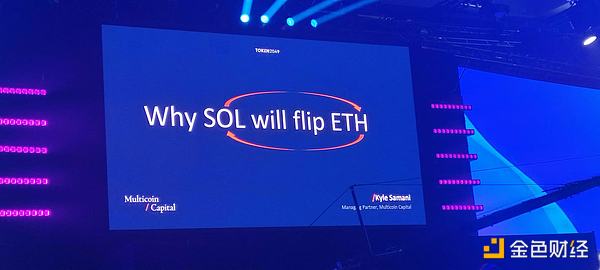
Good morning everyone! I’m Kyle Samani, Co-Founder and Managing Partner at Multicoin. Today I’m going to discuss why we think Solana will surpass Ethereum. Some of you may already agree with this view, some may think it’s too radical, or think it’s unlikely to happen. My goal is to get you to at least rethink the drivers.
Today's talk is divided into three parts. First, I will briefly review the history of Ethereum, because it is very important to understand its current state and problems. Then, I will talk about why Solana is in a favorable competitive position. Finally, we will analyze some key indicators together, which show that Solana has surpassed or is close to surpassing Ethereum, which are on-chain data that Multicoin pays close attention to.
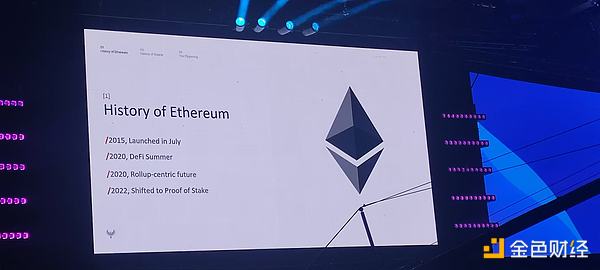
Before I begin, I need to make two legal disclaimers. First, today's remarks only represent my personal opinions and have nothing to do with Multicoin. Second, the content of this speech does not constitute investment advice and should not be considered an offer of Multicoin investment advisory services.
History of Ethereum
Now let's talk about the history of Ethereum. Ethereum is already 9 years old, and it was officially released in July 2015. I think this is very critical and I will emphasize it again and again today. Ethereum has been around for 9 years, and it has had enough time to solve the problems it faces and determine its own development direction. I will discuss these in detail later.
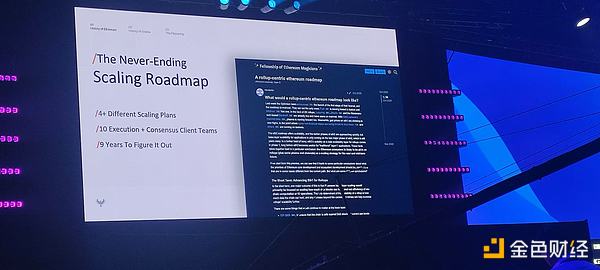
So, what happened in these 9 years? I think there are three very important things. First, the rise of decentralized finance (DeFi), becoming the most important application of blockchain. Although DeFi had some development before 2020, the real outbreak was the DeFi "summer" in 2020. This is 5 years after the launch of Ethereum.
The second big event was Ethereum’s decision to adopt a roll-up-centric scaling roadmap in October 2020, a decision made a few months after the EIP-1559 update. However, an obvious problem with the roll-up roadmap is that it is not DeFi-friendly, leading to issues such as cross-chain bridges and network fragmentation. They announced this roadmap just two months after the DeFi “summer” ended, and the impact is obvious.
The third key turning point is Ethereum's shift from proof of work (PoW) to proof of stake (PoS) in 2022. It is worth noting that the Ethereum community had this plan before the mainnet was launched in 2015, but it took 7 years to realize it. This shows that Ethereum's actions are very slow and there has been a lack of clear direction.
Next, I want to briefly talk about Ethereum's scaling roadmap. To be honest, this roadmap has changed many times, and the earliest proposals included concepts such as Plasma and state channels. If you remember, there were also crazy ideas like Hyperledger at that time. Obviously, none of these came to fruition. In the end, it took them 5 years and officially decided to adopt a roll-up-centric roadmap in October 2020.
However, this roadmap is now also being questioned, or at least partially questioned. In recent public discussions, there have been more and more questions about whether to expand L1 and whether to introduce multiple block proposals. These ideas are closer to the strategies of projects such as Solana and are now re-entering the discussion of Ethereum.
We don't know what decision Ethereum will ultimately make. It may take 3 months, 6 months, or even 9 months to see the result. But I want to emphasize that the roadmap formulated four years ago is now at least partially questioned, and may even be completely overturned. Ethereum has been around for 9 years, but it is now back to the starting point. What is going on?
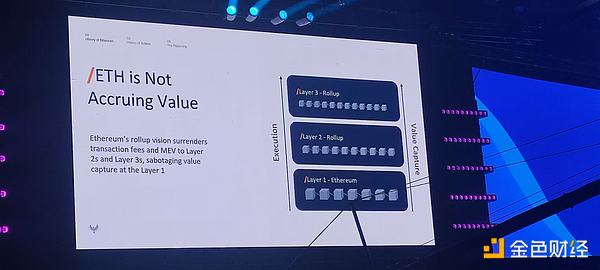
Before discussing Solana, I want to mention one more point: Ethereum is no longer the center of value capture. The roll-up-centric roadmap explicitly shifts transaction fees and MEV (maximum extractable value) fees from L1 to L2, L3, and even L4. Although this roadmap successfully pushed transactions to the L2 layer, it also moved most of the value creation away from Ethereum as an asset.
Ethereum still has no clear direction
These people will tell you that you can still use Ethereum for Data Availability (DA), which is true. But as I will show in the next few slides, the value of DA is almost zero. There is more than enough DA available on Ethereum and elsewhere. People will eventually say that the value of Ethereum comes from "ETH is money", but this is complete nonsense. This statement is essentially a circular argument that cannot be disproven, and they are just imposing their beliefs on you without any logic to deduce.
The litmus test for whether something is money is simple: go to a coffee shop and ask them how they price their coffee. If they price it in ETH, then ETH is money. If they price it in USD, then USD is money, and that is the standard for judging money, and nothing else is the standard.
L2 transaction data

We can see the percentage of transactions that have moved from L1 to L2 over the last three or four years. It's very clear that almost all transactions are now on L2, more than 90% of transactions happen on L2. This is going according to plan, they did achieve their goals, but what is the result? They keep talking about the so-called DA value rule. In fact, L2 is the one who makes money.
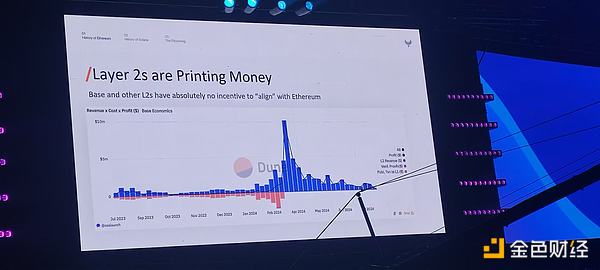
Let's look at the revenue and expenses of Base, which is currently the largest L2 on major metrics. It can be clearly seen that Base's revenue is around $1 million per week, while its expenses are almost zero. The reason for the zero expenses is that they only have to pay L1 fees for DA. By March, Base's revenue dropped to zero and may remain at this level in the future.
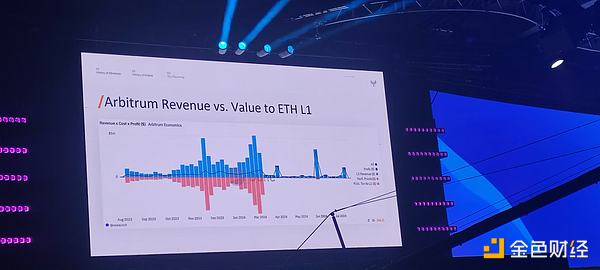
One point I want to highlight is that while people keep saying that L2s are dependent on L1s, in reality, this chart clearly shows that they are in opposition. The purpose of Base is simply to generate profits for Coinbase shareholders, who want to maximize revenue and minimize expenses. In fact, the incentive mechanism of Base is exactly the opposite of the incentive mechanism of Ethereum L1, because Base wants to minimize the fees it pays. If we look at other major L2s, such as Optimism, the chart shows almost the same situation, and Arbitrum is the same pattern. This trend is consistent across all L2s.
Ethereum’s positioning is unclear
I want to be clear that Ethereum has never really been clear about what it wants to be.
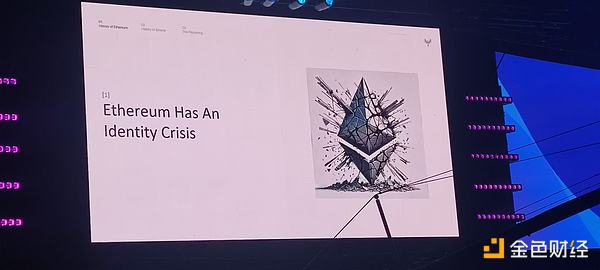
9 years ago, it was launched as the "world computer", but this concept was never really defined, and even now it is not clearly defined. Granted, I don't think they have to define what a "computer" is, it's just a marketing term. But 9 years later, they still haven't told us what the platform is actually used for. Although concepts such as decentralized finance (DeFi), Web3, and decentralized identity storage have emerged, Ethereum currently presents a mixture of these concepts. To be honest, it has become vague and there is no prominent direction. Even a few weeks ago, Vitalik and other members of the Ethereum Foundation publicly stated that DeFi is just a circular argument and suggested that everyone use Ethereum to do something else.
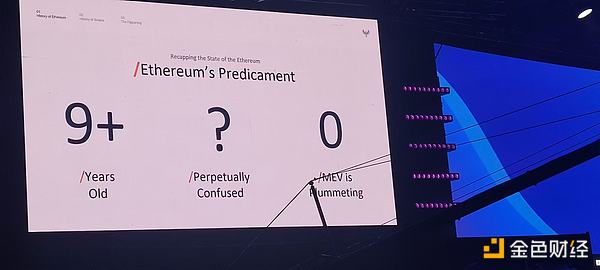
That’s great, and I wish Ethereum would do more. But the problem is, 9 years later, they still haven’t provided clear guidance or any clear opinions. The lack of urgency and clear direction has filled the entire system with negative energy. DeFi is the most important thing on blockchain, whether it’s Ethereum, Solana, or other chains. When I hear people say “DeFi is not important”, I just want to say, if you are not going to optimize DeFi, then tell us what you are going to optimize. But they don’t, because they don’t know themselves.
Let's review: Ethereum has been around for 9 years, it took 5 years to finalize the scaling plan, and another 7 years to complete the transition from Proof of Work (PoW) to Proof of Stake (PoS). Ethereum has never been clear about what it wants to be. The scaling plan keeps changing, with no clear direction. They don't know what they are optimizing for. Because of this roll-up roadmap, they have actually shifted most of the value added from ETH to L2, such as Base and other projects.
Meanwhile, Ethereum’s market cap remains around $300 billion, one of the top 40 assets in the world by market cap. However, the project still has no idea what it wants to be, and this structural problem is very obvious. Next, we will turn to Solana’s history for discussion. Compared to Ethereum, which has never found a clear direction, Solana has always had a clear goal.
The Origin of Solana
Solana's founder Anatoly Yakovenko began conceiving of Solana in 2017 when he was using an American service provider, Interactive Brokers (similar to a more advanced version of Robinhood), to write a trading robot. He found that he could not get real-time market data from the New York Stock Exchange and Nasdaq, while companies like Virtu and Jump Trading could easily get it. He felt that this was very unfair and believed that everyone should have fair and open access to market data.
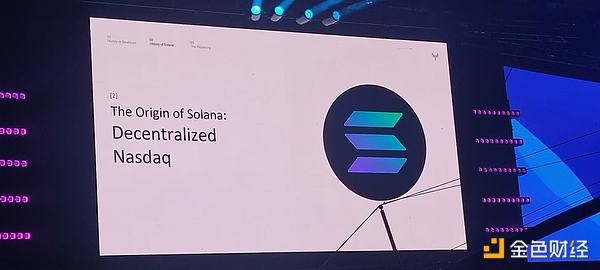
This unequal experience prompted him to develop Solana, with the goal of allowing anyone to access market data in real time 24 hours a day, 7 days a week. The Solana system is designed to optimize the dissemination of information, and anyone with a computer and an internet connection can receive this data in real time. This vision has become Solana's "North Star", guiding them to build a global, real-time decentralized exchange from day one.
Although the process was much more difficult than expected, Solana began development in 2018 and finally launched version 1.0 in 2020. Despite many failures, network downtime, congestion and other problems during the period, they always adhered to this vision. It was not until the version 1.18 upgrade in May 2023 that Solana truly realized this vision. This upgrade enabled the chain limit order, order cancellation and other functions to start operating normally, and transactions were carried out smoothly with almost zero fees.
Solana's success lies in the fact that they have persisted in this difficult and ambitious vision , and although they have experienced failures, the final user experience is excellent, and there are no bridge and fragmentation issues on Ethereum. In addition, Solana's asset value has also increased significantly, and now generates $500 million to $1 billion in revenue each year, mainly from MEV (maximum extractable value). Solana's success proves the power of focus. It took them 6 years to turn their vision into reality.
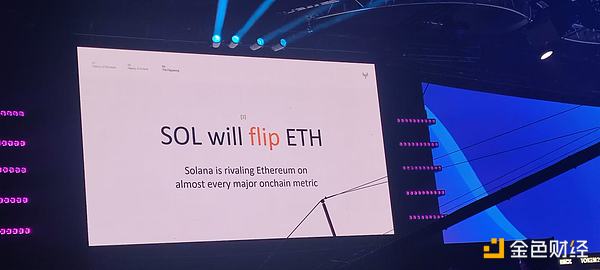
This is why we believe Solana will surpass Ethereum in market cap. Next, we will explore some key on-chain metrics that show that Solana's performance is approaching or surpassing Ethereum.
Beyond Ethereum
First of all, blockchain systems are essentially financial systems. We can see that Solana’s on-chain transaction volume has basically caught up with Ethereum in the past year, and sometimes even exceeded Ethereum. This is the most important indicator in our opinion, after all, the core function of blockchain is to conduct transactions.
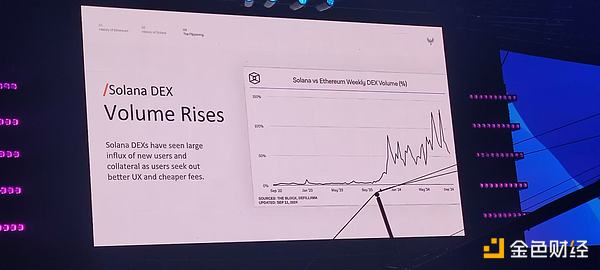
Next, let’s look at the second indicator: validator rewards. Solana has also caught up with Ethereum in this regard, and some weeks Solana’s validator rewards even exceeded Ethereum.
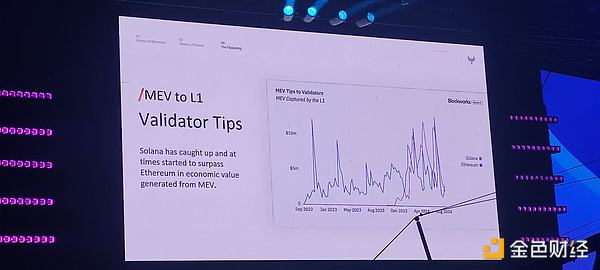
The last indicator is the transfer volume of stablecoins. Although Solana still lags behind Ethereum in this regard, its growth rate is amazing. About a year ago, Solana's on-chain stablecoin transfer volume was 1/10 to 1/20 of Ethereum, and today it is close to half, which shows that funds are flowing more and more on the Solana chain.
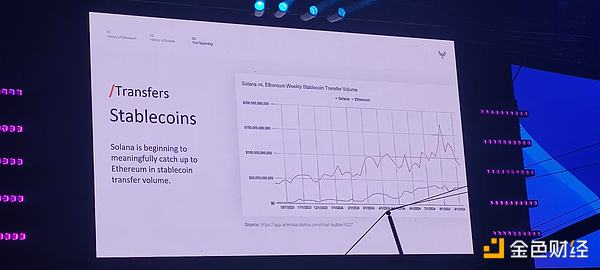
If you believe that these metrics will continue to grow in the same direction, then it is reasonable to assume that Solana’s market cap will also grow in the same direction.
Solana's Structural Advantages

Next, I would like to talk about the future of Solana and its three unique advantages, which are almost impossible to be replicated by other communities and are why we are more optimistic about its future.
The first advantage is the token expansion function
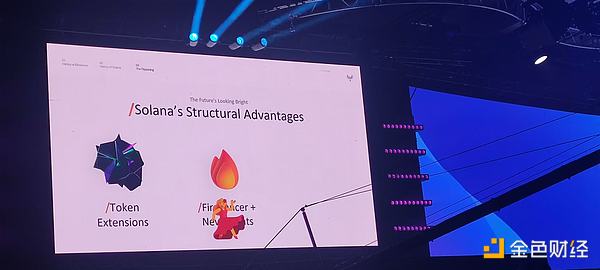
Token extensions were launched earlier this year, which provide payment companies or major global asset issuers with many features, such as built-in yield functionality, confidential transfer functionality (hiding sender and receiver), asset issuance and revocation functions, etc. These features were developed based on direct needs of payment companies and Wall Street and are now live on the mainnet.
The reason I emphasize this is that we not only have DeFi and other decentralized financial tools, but also need to meet the needs of regulated finance. Without these integrated functions, regulated financial companies will not be able to go on-chain at a large scale. And these functions are already fully integrated in Solana's L1 layer and can be used at any time. We think this is a huge advantage of Solana and it is almost impossible to replicate in the Ethereum ecosystem.
Ethereum's EVM (Ethereum Virtual Machine) is fragmented, with many different versions, such as Optimism, ZK-rollups, Polygon, etc. Although they share about 98% of the same code, they are not completely consistent. If you want to establish common standards between these different EVM versions, such as stablecoins with confidential transmission, it is very difficult to get these systems to communicate and cooperate with each other. This is not a technical problem, but a problem of interpersonal coordination. You need to get these different teams to sit down and reach an agreement, which is very challenging.
The first project to use token extensions was Paypal's stablecoin PYUSD, which was mainnet a few months ago. We expect that the token extension function will become one of Solana's signature features in the next 3 to 4 years, and it will make Solana stand out among many blockchain projects.
Firedancer

Next, I want to talk about Firedancer. Firedancer is a brand new Solana client that is going to be released soon, and it is expected to be released in the next few days or weeks. They may announce the exact date at the Breakpoint conference tomorrow. If you are not familiar with it, Firedancer is a new supply client developed by Jump Trading. Jump Trading is one of the largest high-frequency trading companies in the world, and among all high-frequency trading companies, Jump is known for being the fastest.
We think this is really important because the Jump team has applied all of their knowledge and experience in building high-performance trading systems to this client. From the beginning, Solana’s vision has been to build a decentralized Nasdaq, and now we are bringing the wisdom of the world’s leading trading company to build the world’s fastest commission-free exchange. This system will be extremely scalable and fast, and will make the things we like about Solana - composability, no bridging problems, etc. - even better with Firedancer.
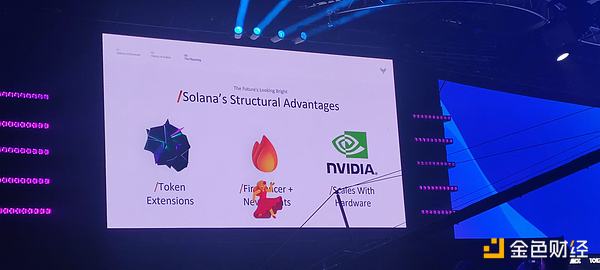
Hardware expansion
The last thing I want to talk about is hardware scaling as it relates to Firedancer. One of Solana’s design principles is to scale naturally through parallel hardware. Solana has been talking about this since day one of the project. I’ve been talking about it for several years. The core idea is simple: if you double or triple the number of cores in your system, you’d expect the performance of your system to double or triple as well. It’s a very intuitive idea.
This idea applies not only to Solana, but also because of Moore's Law, over the past 50 years, and especially over the past 10 to 15 years, systems that can exploit parallelism have achieved significant gains in real-world performance as core counts have increased. Today, this idea is particularly relevant because of the renaissance in AI that is happening, with massive capital inflows into the entire semiconductor value chain, from design to manufacturing, and the fastest growth rate in the past 30 years.
This is all thanks to the explosion of AI chips being developed by a slew of startups, companies like Nvidia and AMD. Most of these chips are highly parallel, and not all of them will be suitable for Solana, but that doesn’t matter, we just need a few of them to be able to adapt, and that will greatly improve Solana’s performance. The amazing thing is that this AI renaissance has nothing to do with crypto. No one in crypto needs to know or care about what’s happening in AI, but $3, $4, or even $50 billion of R&D investment in AI will indirectly drive performance improvements for the Solana network.
This is a key philosophy at the core of the system design: to win what we believe will be one of the largest markets in the world, a decentralized Nasdaq. The EVM (Ethereum Virtual Machine) is a single-threaded processor, and while they have been talking about parallelization for 9 years, there has been no real progress. We think this full embrace of parallel processing will become more obvious in the coming years, especially as the assets on the chain expand.
In closing, we are excited about the future of Solana. Everyone is pulling in the same direction. Everyone is committed to building this decentralized Nasdaq. We have a strong development team, asset issuers, token scaling capabilities, and efficient clients, all of which work together to build a network that can scale and create an asset that increases in value as the network scales. We look forward to seeing further developments in Solana in the coming years.
Thank you everyone!







